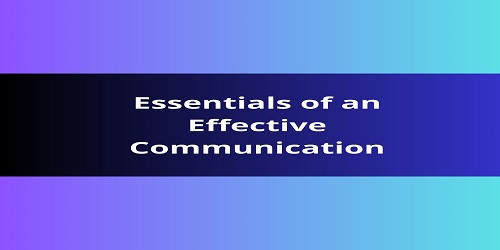Essentials of an Effective Communication:
Different thinkers have tried to list the essentials of efficient and effective communication.
According to Terry, the following eight factors are essential for making communication effective:
(1) Inform yourself fully.
(2) Establish mutual trust in each other.
(3) Find a common ground of experience.
(4) Use mutually known words.
(5) Have regard for context.
(6) Secure and hold the receiver’s attention.
(7) Employ examples and use visual aids.
(8) Practise delaying reactions.
Another writer, Millett, however, lists seven factors as essential elements for making any communication effective. These are:
(1) Communication must be clear.
(2) It must be consistent with the expectations of the recipient.
(3) Adequate Communication.
(4) Timely Communication.
(5) Uniform Communication.
(6) Flexible Communication.
(7) Acceptable Communication.
While discussing the essential elements of effective communication, Richard and Niclander record, “The essentials of communication are that it should reflect the policies, programmes, and practices of the management.”
Chester Barnard, while highlighting the importance of the relationship between communication and organization, holds that it is the means of maintaining and executing authority. He believes that the following seven communications elements are very important in maintaining authority in an organization.
(1) The channels of communication should be definitely known.
(2) There should be a definite formal channel of communication open to every member of the organization.
(3) The line of communication should be as direct and short as possible.
(4) The complete formal line of communication should normally be used.
(5) The persons serving as communication centres should be competent.
(6) The line of communication should not be interrupted while the organization is functioning.
(7) Every communication should be authenticated.
This list given by Chester Barnard has been extended by several other scholars and management study centres.
The American Management Association has given the following ten points for good communication which have to be followed for making communication effective.
(1) Clarify your ideas before you communicate.
(2) Examine within yourself why you are communicating and what is the true purpose of this communication.
(3) Before you launch a communication measure, consider the total physical and human setting which will get involved in the process in which you want to involve.
(4) Consult others for planning because your own subjectivity operates adversely in designing your communication network.
(5) Be mindful of the content of the human messages, because it is possible that the message may be lost in the context, and the overall configuration of the contents may disfigure the message itself.
(6) Convey other things to help him because a communicatee is not only looking forward to a command, but he is curious to seek guidance and assistance.
(7) Follow up on your communication, for it is a chain process that does not stop with the dispatch of a letter or message. It needs to be continuously followed and strengthened at every step on its way. It ensures effectivity and keeps it moving till the attainment of the goal.
(8) Communication is for today as well as for tomorrow. It means the communicator should establish a rapport and establish his own image as a knowledgeable person with sound commonsense and robust pragmatism. This image makes him a better communicator and even those who do not take him seriously today will gradually respond to his communications.
(9) Action supports communication. Communication is not merely letter writing. It is desirable that the communicatee should watch and assess the behavior of the communicator.
(10) Seek to understand before you get understood. Commonly, understanding situations requires more brain than imposing one’s ideas on helpless subordinates as it is not easy to understand others if someone is ignorant.
These factors can help the organization in achieving a shared understanding of shared purposes through communication. If these essentials are not observed, the communication process may break down. We can conclude our discussion of the essentials of good communication by quoting the views of Newman and Summer: “Communication should reflect mutual understanding, mutual respect, confidence and trust that permits frank discussion of personal feelings and problems, and integrity in matching action with words.”









Comments (No)